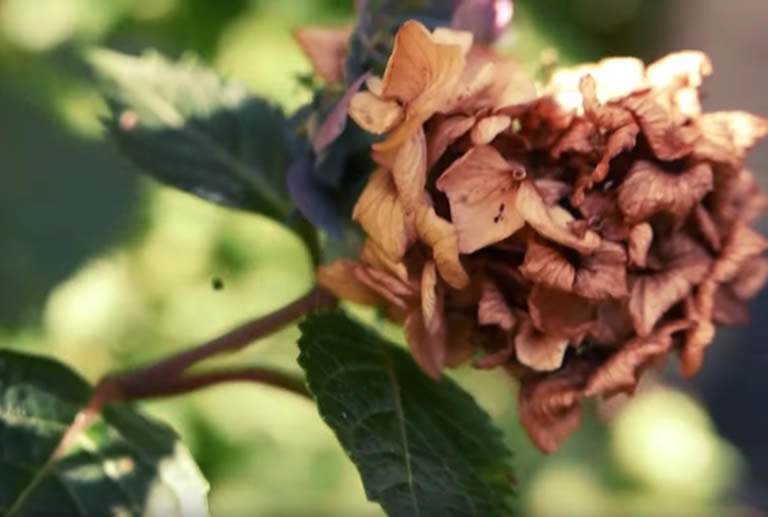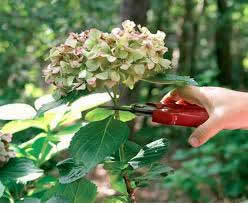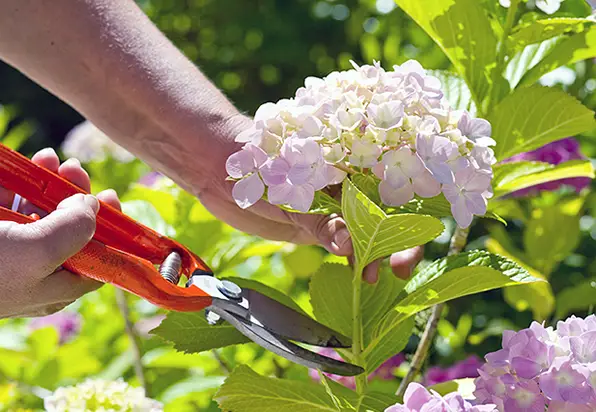How To Deadhead Hydrangeas The Right Way

Caring for flowers can be quite perplexing, as there are times where human intervention is necessary for their growth and times where they should be left alone for their health. Sometimes we need to take action and at other times it’s best to just leave the plant alone. Therefore it is no wonder that many gardeners wonder if deadheading is a good idea when it comes to hydrangeas.
Table of Contents
So, should you deadhead hydrangeas?
Hydrangeas should be deadheaded to maintain their appearance, health, and promote new flower growth in future blooming seasons.
When and how hydrangeas are deadheaded will be subject to seasonal changes, climate conditions in your area, as well as the hydrangea species being cared for.
 Although deadheading hydrangeas is necessary to ensure they grow well and produce plenty of blossoming flowers, it’s vital to understand when and how to deadhead correctly.
Although deadheading hydrangeas is necessary to ensure they grow well and produce plenty of blossoming flowers, it’s vital to understand when and how to deadhead correctly.
Join us in this post as we discuss the benefits of deadheading hydrangeas and how to deadhead them correctly, in order to encourage healthy vibrant blooming throughout the year.
Deadheading hydrangea will encourage new growth when done at the right time
So, should you cut the dead blooms on your hydrangea plants?
Yes, when you’re in the correct season, and the conditions are appropriate, you should trim off the dead hydrangea blooms from your plant.
Since hydrangea blossoms are larger than many other flowering plants, removing these dead blooms will have a massive impact on their energy consumption.
It will also effect their and ability to develop other areas of the plant’s structure, many of which are vital for longevity and overall health.
Dead blooms offer nothing. They distract from the beauty of the plant often making it look unhealthy while they continue to drain water and nutrient resources. Get rid of them.
In addition to the health benefits that deadheading offers, cutting off dead hydrangea spent blooms will improve the overall visual aesthetic of the plant.
Let’s face it, spent blooms are unsightly to look at and take away from the beauty of the plant.
Sometimes spent hydrangea blooms are actually helpful to the plant & should be left alone
However, you should be aware that these dried and faded blooms are helpful for the plant under certain conditions in specific seasons.
In the colder and wetter months these spent blooms can provide, to the rest of the plant, a form of sheltering from harsh weather and extreme temperatures.
This is beneficial particularly for newly forming buds.
New buds are susceptible to adverse weather changes.
Leaving spent blooms on the plant will give the protection needed to sprout healthy new growths in the growing season while also promoting further growth during seasons to follow.
Thus, in order to ensure you are not robbing your hydrangea plant plant of much-needed protection you will need to understand when it is beneficial to cut these dead blooms off the plant. You should also know when it is best to leave them alone.
The most appropriate time and manner for deadheading and pruning hydrangeas will vary depending on seasonal changes. These include harsh weather conditions such as freezing temperatures in winters, and the type of hydrangea species.
I have included a section below with advice for knowing when you should deadhead your hydrangea and when you shouldn’t.
Be aware though that the approach when deadheading will also affect how the plant grows in the future.
Most times deadheading hydrangeas encourages reblooming
Before we get to the process of deadheading the plant you may be wondering what effect this will have on future blooms.
Will hydrangeas rebloom after deadheading?
Hydrangeas will rebloom after deadheading as long as the deadheading process is done correctly.
Deadheading is beneficial for the health of the plant and encourages new growth.
When plant owners deadhead their hydrangeas, the plant reacts to this intervention by allocating more of its resources to the creation of new healthy root, stem, and foliage development.
It also stops spending its energy and resources on the production of seeds.
How your hydrangeas will bloom in the following seasons after deadheading will rely on how and when they are deadheaded.
You really need to get this right.
 Proper deadheading triggers new growth in the plant, and will also affect its ability to produce new flower buds.
Proper deadheading triggers new growth in the plant, and will also affect its ability to produce new flower buds.
In addition, it increases that plant’s ability to protect those new buds throughout colder seasons. It ensures they stay healthy until they are ready to blossom in the following blooming seasons.
So, when and how should you do this?
Failing to deadhead hydrangeas at the right time often leads to slow plant growth
What happens if you miss your opportunity to deadhead spent blooms on your plant or simply forget to do it? What happens if you don’t deadhead hydrangeas?
When you don’t deadhead your hydrangeas the plant will either grow slowly or stop growing completely.
Pruning and deadheading hydrangeas promotes new growth, thus encouraging the plant to focus more on foliage and root health.
A lack of pruning often results in the plant spending most of its energy and resources on seed development (for the propagation of new plants).
Its remaining resources may then go to other tasks as opposed to flower and leaf development on the existing plant.
Obviously, this redirection of resources can lead to impeded plant growth.
Thus, if you do not prune your hydrangeas, especially in relation to removing spent blooms, it may lead to impeded growth in the plant further down the line and result in a range of visibly undesirable effects.
In most cases, a lack of thorough and timely pruning will be indicated by the plant through specific adverse side effects such as lack of new blooms and halted plant growth.
Other undesirable repercussions due to a lack of pruning can also include the hydrangea blooms fading in color or even turning brown.
These indicators should be observed and noted when determining future routines and interventions for your specific hydrangeas.
Although deadheading hydrangeas has an instant and positive effect on the aesthetics of the plant, pruning in general can seem harmful at first to some plant owners.
This is especially true if you are removing fading blooms that are not completely spent.
However, taking the action to deadhead your hydrangea really is beneficial for the plant’s health.
It frees up resources that allow the plant to continue growing new foliage and flowers while feeding the existing healthy ones.
So to quickly sum up: plant owners should always ensure that they deadhead their hydrangeas at the correct time of year.
They should use suitable approaches and equipment to avoid the risk of fading or browning blooms that are still healthy.
Deadheading simultaneously encourages new growth and the development of brighter and stronger foliage and blooms.
When you should deadhead hydrangeas and when you shouldn’t
You should really aim to deadhead your hydrangeas all through the blooming seasons.
This actually includes late winter in some climates as well as throughout the spring.
Understand how to check and your use your climate zone effectively here.
Late winter and spring are times of the year that are often best for encouraging further growth of foliage and roots in hydrangeas and also for promoting the development of new flowers.
However, hydrangeas should not be deadheaded and pruned all year round.
Deadheading them during certain seasons can have adverse effects on their development throughout the rest of the year.
When are those times?
You should not deadhead your hydrangea shrubs during mid to late fall and in early winter.
You should leave all fading blooms on the plant during this time, as removing them will affect the plant’s ability to grow and develop during the winter and future blooming seasons.
Leaving hydrangeas alone, i.e. not deadheading spent blooms, during mid to late fall will allow the plant to maintain its health throughout the entire winter.
It will also encourage the retention of existing buds, which may bloom into flowers during the following spring.
That being said, the most appropriate time to prune and deadhead hydrangeas will rely on seasonal changes as well as the hydrangea species variant.

Some species, including those with large leaves, benefit from pruning or deadheading after the first set of flowers has sprouted from the previous year.
In contrast, other hydrangea species, such as smooth hydrangeas, will benefit from being deadheaded immediately.
Species such as the climbing hydrangea may be pruned or deadheaded after they flower in summer.
So, if you are unsure about the specific needs of your own hydrangeas species, a simple internet search will let you know what time of year is appropriate for deadheading your particular plant.
How to deadhead hydrangeas the right way
Thankfully, deadheading hydrangeas is quite a swift and straightforward process, as it only requires a clean pair of pruners.
Be sure that your pruners are wiped down with the appropriate type of denatured alcohol intermittently to prevent the introduction of disease to the plant.
You will also need a pair of gardening gloves and a container that can be used for sections that are trimmed off.
The pruners really need to be wiped down with the denatured alcohol in between snips, as this preventative measure will ensure that potential diseases are not transferred to other areas of the plant.
This might seem a bit excessive but trust me since I started doing this I have dramatically reduced the amount of problems my plants have had after pruning.
When pruning you will need to follow each fading bloom’s stem to the next set of large foliage and identify an area well above the newly forming buds where you can make the cut.
This area is where the hydrangea will need to be deadheaded, and you should always follow this rule-of-thumb as snipping blooms off in random areas will not encourage the plant’s flower growth in the same way.
You will greatly diminish the positive growth results you usually get from deadheading if you don’t follow this advice.
You should also take care when snipping as it may affect stem growth in various ways. make sure you have a good pruner that is sharp and can make a clean, quick cut.
Thanks for reading! I'm Michael — houseplant fanatic and your Pinterest plant guide.
Follow me on Pinterest for fresh updates 🌿



